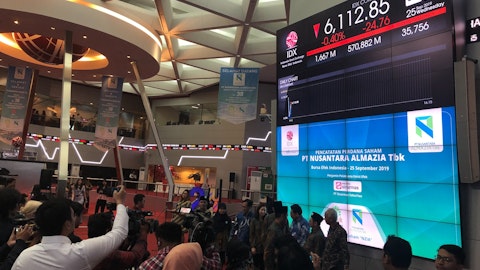Knight-Swift Transportation Holdings Inc. (NYSE:KNX) Q3 2023 Earnings Call Transcript October 19, 2023
Knight-Swift Transportation Holdings Inc. beats earnings expectations. Reported EPS is $0.41, expectations were $0.39.
Operator: Good afternoon, my name is Ludie and I’ll be your conference operator today. At this time, I would like to welcome everyone to the Knight-Swift Transportation Third Quarter 2023 Earnings Conference Call. All lines have been placed on mute to prevent any background noise. [Operator Instructions] Speakers from today’s call will be Dave Jackson, President and CEO; and Adam Miller, CFO. Mr. Miller, the meeting is now yours.
Adam Miller: Thank you, Ludie. Appreciate that. Good afternoon, everyone, and thank you for joining our third quarter 2023 earnings call. Today, we plan to discuss topics related to the results of the quarter, provide an update on current market conditions, and update our 2023 guidance. We have slides to accompany this call, which are posted on our investor website. Our call is scheduled to last one hour today and following our commentary, we’ll answer as — we’ll answer questions related to these topics. In order to get to as many participants as possible, we’re going to limit the questions to one per participant. If you have a second question or a follow-up, please feel free to get back into the queue, we’ll answer as many questions as possible.
If we’re not able to get to your question due to time restrictions, you may call 602-606-6349 following the call and we’ll answer as many questions as possible at that point. So to begin, I’ll first refer you to the disclosures on Slide 2 of the presentation and I’ll also note the following. This conference call and presentation may contain forward-looking statements made by the company that involve risks, assumptions, and uncertainties that are difficult to predict. Investors are directed to the information contained in Item 1A, Risk Factors, or Part 1 of the company’s annual report on Form 10-K filed with the United States SEC for a discussion of the risks that may affect the company’s future operating results. Actual results may differ.
Before we get into the slides, I want to turn the call over to Dave for a few opening remarks. David Jackson Thank you, Adam. And hello, everyone, and thank you for joining our call today. As has been widely reported, we continue to be in a depressed truckload freight market where rate expectations from shippers are often close to, if not, below operating cost. Spot rates are at or not at sustainable levels and are proving not to be survivable for those that are dependent on that type of freight. When we did our last call a quarter ago, there were rumors of Yellow closing. Obviously, since that call, that has indeed taken place and the already resilient LTL market has seen more strength. On the truckload side, the announcements of failures and rumors of more seem to be increasing by the week as of late.
It’s taken a lot to get to this point, so deep along the bottom of this current cycle. But the market is beginning to show signs of sensitivity to when supply leave suddenly or our provider cannot perform with freight lanes that were awarded by offering the cheapest price and shipper may find themselves quickly seeking a quality provider at a higher price than the original award. However, we are not seeing enough of that kind of activity or enough supply leave and/or enough strength in volumes to move rates to a meaningful inflection position right now. But it does appear that the stage has been set for positive rate pressure in the next bid season. In the meanwhile, here at Knight-Swift, we are focused on three specific objectives. The first one is, improving the performance of our truckload businesses.
There is much in our control that we can do, including being better at cost, running more miles safely, and in hiring and retaining driving associates. Our people are digging in, working hard. We’re grateful for that. The truckload operating ratio excluding US Xpress was a 91.5% and we are just simply not comfortable with an OR that starts with the nine and our people are working with urgency to do all that we can. Another objective is to grow our LTL network, AAA Cooper and Midwest Motor Express seamlessly operate on one operating network, while maintaining their local identities. We’ve opened 14 LTL service centers organically since the acquisition of AAA Cooper and MME in 2021. We’ve already purchased 11 additional terminals that have not yet been launched their service centers and we’ll continue to pursue acquiring additional terminals that fit our nationwide plan in addition to other strategic forms of growth for LTL.
We have found synergies between LTL and Truckload business, while not getting in one another’s way. And the third objective that I would point out is the turnaround of US Xpress. We feel like we had good momentum going into the close of the transaction with the goal of being able to hit the ground running and it feels like that’s what’s happened. We’ve had positive sequential rate improvement, while lowering cost per mile in the first quarter of our ownership despite strong market pressure in the contrary. Still long ways to go, but we are ahead of schedule. The people at US Xpress have been great and we’re so excited for where that business is headed and with some help from the market, we will get there even sooner. Now, we’ll turn our overview to Slide 3.
The charts on slide three compare our consolidated third-quarter revenue and earnings results on a year-over-year basis. These results now include the results of US Xpress for the full quarter. Revenue excluding fuel surcharge increased 7.6%, while our adjusted operating income declined by 60.8%. Market conditions in the LTL business were strong while soft demand continues in the truckload space. GAAP earnings per diluted share for the third quarter of 2023 were $0.37 per share and our adjusted EPS came in at $0.41 per share. These results were negatively impacted on a year-over-year basis by a $20.4 million increase in interest expense and the $22 million reduction in operating income in our third-party insurance business with the non-reportable segments.
Also, the third-quarter GAAP results were positively impacted by a $14.6 million income tax benefit from the partial release of a tax benefit valuation allowance held by US Xpress associated with net operating losses and the tax credit carry-forward benefit at the time of the acquisition. This benefit was recognized post-closing due to the ability of Knight-Swift to utilize those tax attributes, which had the effect of reducing the consolidated effective tax rate at Knight-Swift to negative 2.1% for the current quarter. Our adjusted EPS of $0.41 is calculated using a normalized 23.2% effective tax rate for the quarter and excludes the $0.09 per share benefit of the lower tax rate. Now on to Slide 4. This slide illustrates revenue and adjusted operating income for each of our segments.
Freight demand in the third quarter remains stable at soft levels for truckload but fairly strong and building in LTL. The truckload seasonal build usually seen in the late third quarter was subdued and this has continued thus far in early October. Our insurance business performed worse than expected. But this was largely offset by LTL in US Xpress performing ahead of our plan in the quarter, while our existing truckload businesses were largely in line. Contractual bid rates are largely baked in at this point for the 2024-2023 in the truckload business, while project opportunities are less prevalent than a normal peak season but are continuing to materialize. After generally falling for much of the past few quarters, fuel prices increased throughout the third quarter, providing a new headwind to operating margins for truckload and intermodal, though our efforts to reduce costs largely offset the impact.
Our existing logistics business did a great job navigating significant declines in volume and revenue per load year-over-year to maintain a low-90s adjusted operating ratio excluding US Xpress logistics. I’ll now turn it over to Adam to discuss each segment’s operating performance, starting with truckload on Slide 5.
Adam Miller: Thanks, Dave. For the Truckload segment, the ongoing soft demand, further rate pressure, and a recent sustained increase in fuel prices were headwinds to operating margins in the third quarter. However, our actions to reduce costs offset these challenges to produce a slight sequential improvement in adjusted operating ratio for our existing truckload business, excluding the results of US Xpress. The inclusion of US Xpress negatively impacted the adjusted operating ratio for this segment by 340 basis points. On a year-over-year basis, our truckload revenue excluding fuel surcharge, increased 21.9%, reflecting a 15.5% decline in the existing truckload business prior to the inclusion of US Xpress. Revenue per loaded mile fell 14% in total or 11.8% before including the US Xpress truckload business as the spring bid activity is now fully realized.
Excluding the results of US Xpress, miles per tractor increased 1% for the first year-over-year increase in 2023. Including the results of US Xpress, miles per tractor increased 5.1% year-over-year. The decline in rates, partially offset by the improvement in miles per tractor produced an 8.2% decrease in revenue per tractor year-over-year. Now we’ll move to Slide 6. The benefits of our diversification into LTL really stood out as this segment continues to perform well, aided by the recent disruption in the industry. Our LTL business grew revenue excluding fuel surcharge nearly 7% year-over-year and delivered an 84.9% adjusted operating ratio. Pricing growth strengthened as revenue per hundredweight, excluding fuel surcharge increased 10.7% year-over-year.

A row of semi-trucks, highlighted against an expansive sky.
Volumes built throughout the quarter as shipments per day increased 4.8% year-over-year, which reversed the trend of decline seen in the first half of the year. As Dave mentioned, we’ve brought on 14 new service centers online since entering the business in late 2021 and efforts are underway to continue growing this number with properties in various stages of procurement, development, or reconditioning. Filling out a super-regional network in the short-term and creating a national network in the long-term will allow us to participate in more freight and enable us to find opportunities to further support our existing truckload customers with LTL capacity. This remains a key strategic priority for us. Now on to Slide 7. The logistics market is in a difficult phase, where freight demand has been soft for over a year is producing topline price pressure that is no longer being offset by corresponding declines in purchased transportation costs.
Despite these challenges, our existing logistics business remained disciplined and nimble, maintained a low-90s adjusted operating ratio before the inclusion of US Xpress. The US Xpress logistics business is already showing sequential improvement in adjusted operating ratio since the acquisition, closing it within 300 basis points of our existing logistics business, as we improve the cost structure and pricing even in a difficult environment. Overall, revenue was down 24.5% year-over-year as revenue per load declined 15.8% and load count declined 10.3%. Excluding the US Xpress logistics volumes, load count was down 29.7% year-over-year in the existing business. Now if you move to Slide 8. I’ll cover our intermodal segment. Revenue declined 22.6%, which was driven by a 26.6% decrease in revenue per load, which was partially offset by an increase of 5.5% in load count.
The operating ratio improved 190 basis points since the second quarter as a result of cost reductions, which offset a slight sequential reduction in revenue per load. This business improved during the quarter, reaching breakeven in September and we expect modest profitability in the fourth quarter. Now on to Slide 9. This slide illustrates our non-reportable segment, which includes insurance, maintenance, and equipment sales and rentals under the Iron Truck services brand, as well as equipment leasing and warehousing activities. For the quarter, revenue declined 14.2% year-over-year, largely as a result of our actions to address the recent challenges within our third-party insurance program, including significantly reducing the exposure basis.
The $5.4 million operating loss within the non-reportable segment is modestly improved from the $7.1 million operating loss in the second quarter as improvement within other services provided greater offset to the ongoing losses within the third-party insurance business. We are evaluating strategic alternatives for the insurance business, including potential reinsurance strategies for the outstanding liabilities in order to help insulate our business from the volatility primarily arising from prior loss year’s. As noted previously, it will take some time for the changes in the insurance business to fully materialize in the results, but we are making progress, raising premiums and improving the quality of risk as we work to mitigate volatility.
Now, I will turn it over to Dave for an update on the progress of US Xpress.
David Jackson: Thanks, Adam. The team at US Xpress has really rallied around the goal of making significant improvements to this business and is currently running ahead of plan, as previously mentioned, on our projected path to reach an operating profit within the first half of next year. As noted in previous slides, the US Xpress Truckload and Logistics businesses have already made meaningful progress improving their operating ratios. Coming out of the third quarter, we have already reached a $100 million annualized run rate of realized synergies with a target of increasing that to $120 million run rate by the end of this year. We highlight some of the progress on this slide. You’ll notice these are fundamental areas of the business, some of which are the most critical levers to pull-through cycles.
Ultimately as we lower cost per mile, and increase rate per mile, we will make operating ratio progress and that has begun. US Xpress is rolling out a decentralized terminal-based operating model similar to Knight-Swift where there is P&L accountability at the local level with far more personal driver interaction. Nine out of the 10 locations have been converted from places to park to operating terminals. Understanding where rates need to be for a proper return has led to the elimination of brokers as the business is now dealing directly with shippers, while significantly reducing exposure to spot rates versus contract rates, which has improved from approximately 45% at the beginning of the year to approximately 15% today. This is an uphill battle as we close this transaction at the end of the spring bid cycle in July, but the team has made progress and we’ll continue as we will soon begin the 2024 bid season.
We are excited for this early progress and for how this consequential truckload business is positioning for the future. We have been impressed with the effort and attitude of our new fellow teammates at U.S. Xpress and appreciate their hard work. Next to Slide 11 for our outlook. Slide 11 contains our updated outlook on market conditions for the remainder of 2023. The LTL market should continue to see solid demand as the recent capacity disruption in the industry continues to be sorted out over the next several months. This should support further yield improvement and as the new business is increasingly repriced through bid activity. In the truckload space, we believe we are moving past inventory destocking. Those shippers caution about the direction of the US consumer behaviors governing freight demand for the time being it feels.
We continue to expect a modest peak season, including a return of some typical seasonal activity and project opportunities with opportunities continuing to materialize. Spot rates seem to have bottomed, but have yet to inflect positively. As a result, contract rates continue to be pressured. The soft demand, unsustainably low rates, ongoing inflation, and restrictive financing conditions will keep pressure on carriers, especially smaller and less well-capitalized carriers. These factors should serve to accelerate the ongoing capacity attrition and limit immediate capacity expansion upon recovery. The pace of cost inflation should ease, though plentiful work alternatives in the general economy will pressure hiring and utilization until freight conditions improve.
New equipment availability continues to improve and the used equipment market weakens further as small carriers struggle in capacity exits. I will now turn it back to Adam to cover our 2023 guidance on Slide 12.
Adam Miller: All right. Thanks, Dave, and this will be our final slide. For the full-year 2023, we now expect adjusted EPS to be in the range of $2.10 to $2.20 per share, which is an update from our previous guidance of $2.10 to $2.30 per share. This is based on our expectation that truckload rates have stabilized at current levels for the fourth quarter. The truckload tractor count will be down modestly with miles declining sequentially similar to prior year in the absence of a strong peak. The LTL revenue excluding fuel surcharge increases in the mid-teens year-over-year, with a relatively stable sequential margin profile. The LTL shipment count in revenue excluding fuel surcharge per hundredweight improve at high single-digit percentage year-over-year.
The U.S. Xpress EPS estimated dilutive impact in the fourth quarter expected at less than or around $0.05, I believe, as performance continues to improve. Logistics volumes and revenue per load remain under pressure in Q4 with OR stable in the low 90s. The intermodal operating ratio is slightly profitable with volume stable sequentially. The non-reportable op income decline roughly $10 million to $15 million sequentially as third-party insurance stabilizes and other businesses experienced their typical seasonal slowdown in the fourth quarter. We expect some easing cost pressure in the fourth quarter as we realize further cost-containment efforts on some of our cost initiatives. We expect gain on-sale to range from $8 million to $12 million, which includes now disposals at U.S. Xpress.
And we expect minimal increase in interest expense from Q3, assuming the rate hiking cycle is largely complete. And our net cap — cash CapEx is expected to be between $770 million — $750 million for the full year 2023 and that we expect our tax rate to be approximately 26% for the fourth quarter. So that now concludes our prepared remarks. And so Ludie will now turn it to you to open the line for questions.
See also 22 Highest Paying Countries for Caregivers and 20 Most Egalitarian Countries in the World.
Q&A Session
Follow Knight Transportation Inc (NYSE:KNX)
Follow Knight Transportation Inc (NYSE:KNX)
Operator: Thank you. [Operator Instructions] Your first question comes from the line of Ravi Shanker from Morgan Stanley. Your line is open.
Ravi Shanker: Thanks. Good evening, everyone. So, Dave, I think you said at the top of the call that you do expect to see some positive pricing momentum going into 2024. It seems hard to fathom with spot and contract rates where they are right now, but you also have spoken of cost inflation a fair bit. Can you unpack that a little bit more kind of what’s the early signs on bid season looking like? Are we looking at flat first half and a positive second half or something even better than that?
David Jackson: Yes. I would say that, that comment is largely based on the economic position of the providers of full truckload transportation today. I think, we’ve seen in the reports between second quarter and what we’ve already seen reported out for third quarter, I mean, you have really record-tight margins in the full truckload space. And this is all while driver wages, which are by far our largest expense have not increased since 2021. And we likely will have some pent-up increase to work through as perhaps truckload is losing pace in recruiting vocational labor in the economy. And so, it feels like, we don’t have the benefit or opportunity to be aggressive in pricing. In fact, we need a little bit of help. And as we noted last quarter, this is a unique freight recession or trough of a freight cycle, in that normally when we’ve seen it so prolonged, so pronounced, we’re in a broader economic recession.
And so, we naturally get cost concessions in the areas of fuel and labor and equipment. And in this case, we’ve seen the opposite. And now, fuel is kind of turned from being more neutral into now being more of a headwind on the truckload side. So that’s how this is being set up. It feels like there are and what I referenced in my comment is, we’ve seen some situations where it appears that pricing lanes are meaningful bid awards were awarded to carriers at levels that we just don’t understand how that would be possible from a rate perspective. And what we have found is, some of that has made its way back through — often it’s done through a mini bid as we call them, where perhaps the service level wasn’t where it needed to be or they just couldn’t deliver on it.
And so we’re starting to see some of those signs. That tells us that maybe things have been pushed to the limit. And so, we’re here hunkered down, just working as hard as we can to be as efficient as we can. We have virtually no margin for error on the truckload side of the business right now. And we don’t think that we’re alone in that. Now I would guess that the — our optimism of what could happen and what would need to happen in a bid season might not be the same as shippers might view right now. Truckload doesn’t do cost-based pricing. That’s more covered in the LTL space as we’ve learned. But it isn’t the case for truckload, but that really is what’s driving us. This is not elective, this is just the essential. And so we’ll have to see how it plays out.
If the bid season began right now today, we would really have a tough time, seeing it to be positive. But as things continue to materialize, I think that natural conditions are going to lead us in that direction.




